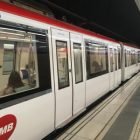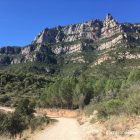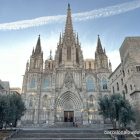The Barcelona tram system is divided into two separate networks which run through the suburbs to municipalities north and southwest of the city.
To the south of the city, the Trambiax consist of three lines (T1, T2 and T3) which run from Plaça Francesc Macià to Espluges de Llobregat, Cornellà de Llobregat, Sant Feliu de Llobregat, Sant Joan Despí and Sant Just Desvern.
To the north, the Trambesòs (lines T4, T5 and T6) runs from the Parc de la Ciutadella, through the Sant Martí district to Badalona and Sant Adria de Besòs.
Later this year (2021), work will begin to connect the two networks by building a new line that crosses the city centre along Avinguda Diagonal.
This post contains everything you need to know about Barcelona’s tram system.

Barcelona Tram System Guide
- Barcelona Tramlines and maps
- The Tram system and transport zones
- How to use the tram in Barcelona
- Barcelona Tram system opening times and timetables
- Tickets and travel passes
- Tram stations
- Validating your ticket
- Invalid or damaged tickets
- Transferring between the tram and metro, train or bus
- Wheelchair access and mobility scooters
- The history of trams in Barcelona
- Barcelona tram system FAQ
Barcelona Tramlines and maps
Barcelona’s tram system consists of six lines which are currently divided into two networks:
TRAMBAIX
The Trambaix network runs through Barcelona’s southern suburbs to Espluges de Llobregat, Cornellà de Llobregat, Sant Feliu de Llobregat, Sant Joan Despí and Sant Just Desvern. The network consists of three lines (T1, T2 & T3) and links up with Barcelona’s metro and train systems at several points.

T1 Sant Joan Despí – Plaça Francesc Macià
Tram T1 runs from Sant Juan Despi to Plaça Farancesc Macià in Barcelona. The line has twenty-one stops five of which connect to either commuter train lines or the Barcelona metro system.
T2 Llevant I Les Planes – Plaça Francesc Macià
Tram T2 follows the same route as line T1 but continues for an additional three stops to Llevant – Les Planes.
T3 Sant Feliu de Llobregat – Plaça Francesc Macià
Tram T1 runs from Sant Feliu de Llobregat to Plaça Farancesc Macià in Barcelona. The line has a total of twenty stops, five of which connect to the Barcelona metro system.
TRAMBESÒS
The Trambesòs network runs through Barcelona’s northern suburbs to Badalona and Sant Adria de Besòs. The network consists of three lines (T4, T5 & T6) and links up with Barcelona’s metro and train systems at several stations.
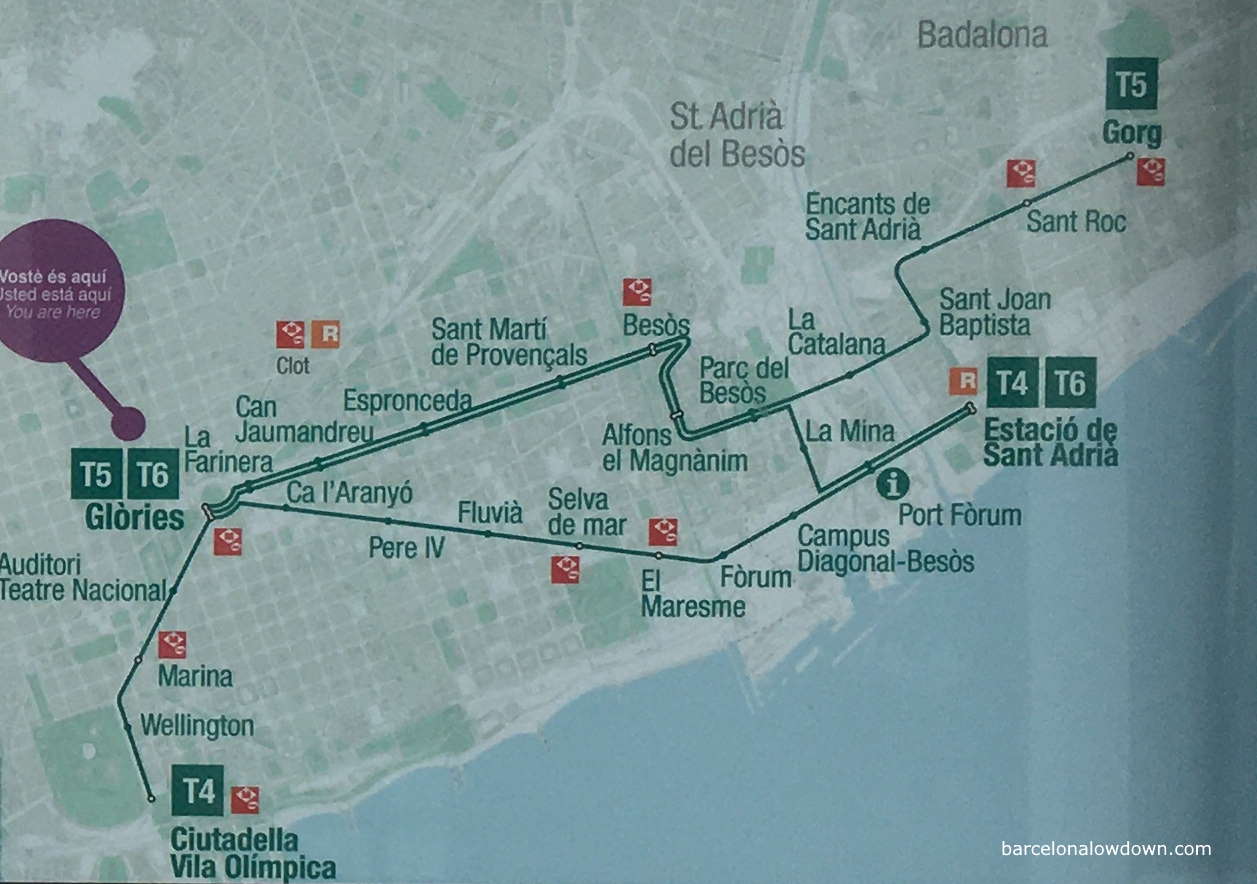
T4 Sant Adrià de Besòs – Ciutadella/Vila Olímpica
Tram T4 runs from Estació de Sant Adrià through the Poblenou and Eixample neighbourhoods to El Parc de la Ciutadella. The line has fourteen stops, seven of which connect to commuter train lines or the Barcelona metro system.
T5 Badalona – Glòries
Tram T5 runs from Badalona through Sant Adrià and that Sant Martí district to Plaça de les Glòries Catalanes. The line has thirteen stops, four of which connect to the metro system.
T6 Sant Adrià de Besos – Glòries
Tram T6 runs from Estació de Sant Adrià through the Sant Martí district to to Plaça de les Glòries Catalanes. The line has eleven stops, three of which connect to either the commuter train or the metro networks.
The Tram system and transport zones
Fares for Barcelona’s public transport system are based on six zones. Both tram networks are entirely within transport zone 1.
There’s more information about Barcelona transport zones in this post >>
How to use the tram in Barcelona
Barcelona’s tram system is modern, clean, efficient and easy to use. This post contains everything you need to know when travelling by tram in Barcelona.
If you have any questions, please leave a comment below, and I’ll get back to you as soon as I can.
Barcelona Tram system timetables and opening times
Trams run during the periods shown below. At peak times, trams depart every ten to fifteen minutes; this drops to every thirty minutes early in the morning and during the evening.
As can be seen from the maps above, in many sections, two or three trams serve the same route, which means that you might not have to wait so long for the next tram.
| Day | Time |
|---|---|
| Mon – Thurs | 05:00 – 24:00 |
| Friday & Saturday | 05:00 – 02:00 |
| Sunday | 05:00 – 24:00 |
| The night before public holidays | 05:00 – 02:00 |
Tickets and travel passes
Single tickets for the tram currently cost €2.40 and can be purchased from vending machines at the tram stations (card or coins only).
You can save money and time by purchasing a multi-trip ticket such as the Hola Barcelona Travel Card, T-Casual or T-familiar.
The Barcelona Card offers free entry to popular museums and tours as well as unlimited use of public transport within transport zone 1.
There’s more information about Barcelona sightseeing cards and travel passes in this post >>
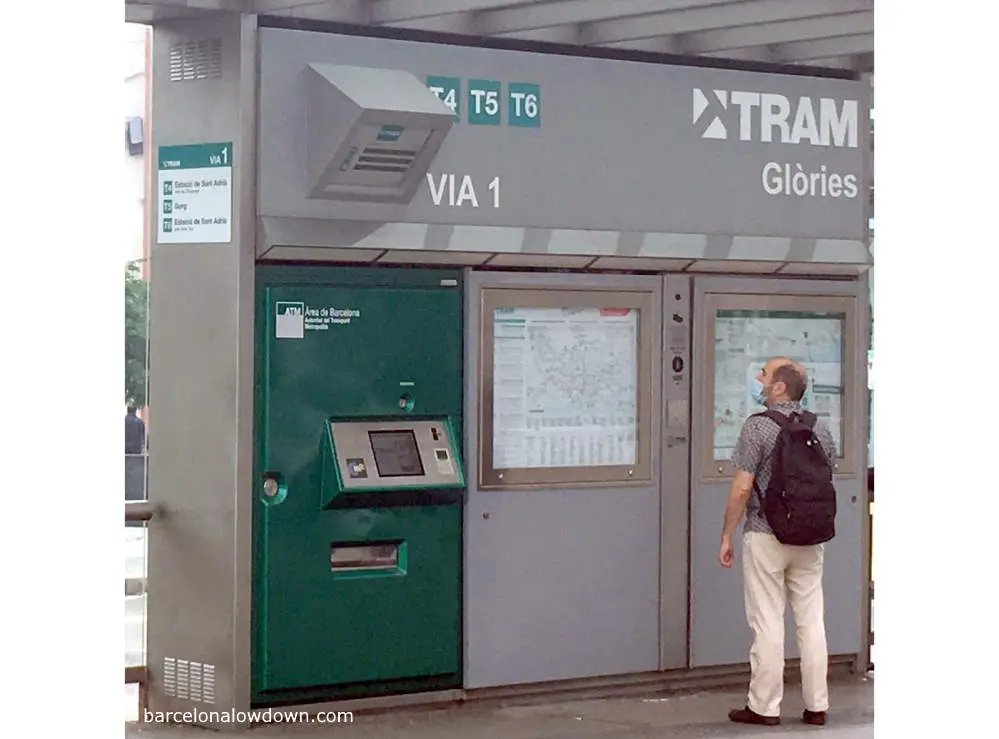
Tram stations
Stations consist of raised platforms that make access to the trams very easy. Icons on the platform indicate where the dedicated area for wheelchair users will stop.
There’s a ticket vending machine in the middle of the platform where you can purchase tram tickets, including single tickets and T-casual or T-familiar travel passes. The machines accept credit or debit cards plus coins. They don’t take notes but do give change. Most European credit cards with a chip and four-digit PIN are accepted.
Directly above the ticket vending machine, an LCD screen shows when the next tram will arrive. In addition, there are maps of the tram network and the metro and urban train system. If you need assistance, there’s an intercom located between the maps.
When a tram stops at the station, the doors will open automatically. If they don’t open automatically, there are buttons on the doors that illuminate when they are activated.
Validating your ticket
When entering the tram, you have to validate your ticket using the machines located near the doors (see photos below). Failing to do so means that you are effectively travelling without a ticket.
Insert the ticket into the slot at the top of the machine with the arrow facing downwards and the printed side of the ticket towards you. Once inside the machine, the ticket is stamped. A green LED next to the ticket slot illuminates, and the machine beeps once before returning the ticket, indicating that it has been validated correctly. You should keep your ticket for the entire duration of your journey and show it to inspectors if requested.
If the red LED lights up, this indicates that the ticket hasn’t been correctly validated. The ticket may be damaged or may have expired. The most common cause of a ticket being rejected is that it has been inserted incorrectly. Check the orientation as described above and try again.
Three stations on tram line T5 have ticket barriers that validate your ticket as you enter this station. When boarding the tram at these stations, you don’t need to validate your ticket again inside the tram.

Invalid or damaged tickets
If the machines within the tram repeatedly reject your ticket, it has either expired or has been damaged. Unfortunately, when this happens, your only option is to leave the Tram and purchase another ticket from the machine at the station.
Damaged travel passes and tickets can be replaced free of charge by staff at customer service offices and at the ticket offices of metro and train stations. The station at Plaça de Catalunya is the most convenient for the majority of visitors.
Insider’s tip
Very occasionally, tickets get stuck inside the validating machines without getting stamped. I don’t know why this happens, but it’s happened to me several times over the years.
You can get the ticket back by inserting another ticket into the top of the machine. The first ticket will then be expelled from a slot at the bottom of the machine. You can then insert the ticket into the top of the machine and validate it as usual.
If the second ticket has already been validated, it will not be stamped again.
Transfering between the tram and metro, train or bus
A single tram ticket allows you to transfer between different lines of the tram network as part of the same journey during a period of thirty minutes after the ticket was first validated. When transferring from one tram to another, you must validate your ticket again when boarding the tram.
Single tram tickets can not be used when travelling by metro, bus or train.
If you have purchased an integrated, multi-trip ticket such as the Hola Barcelona Travel Card, T-casual or T-familiar, you may transfer between different modes of transport as part of the same journey. You must validate the ticket again each time you board a tram or bus or enter a metro station but, assuming you are within the allowed time period; the ticket will not be stamped again. More information in this post.
Wheelchair access and mobility scooters
All tram stations are accessible for wheelchair users. The platforms are at the same level as the wagons, ensuring easy access to and from the train. Inside the tram, there is a designated area for wheelchair users with straps to secure the chair and where the ticket validating machine is at a height that facilitates its use. In addition, the nearest doors area are marked with a wheelchair icon, and there are icons on the platform indicating where the doors will be located when the next tram arrives.

The history of trams in Barcelona
Barcelona’s first tram service was inaugurated in 1872 and connected Las Ramblas with Plaça Lesseps. The earliest trams were pulled by horses, but they were superseded by steam trams as the network expanded.
The steam-powered trams were both noisy and dangerous. Apparently, they were involved in so many accidents that the locals referred to the lines by nicknames including “the guillotine” and “King Herod” because they killed innocent children. [source]
The first electric tram was inaugurated in 1899, and new lines were built reaching as far afield as Badalona and the Tibidabo theme park, which opened in 1905.
Two years later, the first buses began circulating, and a price war began between the two forms of public transport.
During the 1920s, work began on Barcelona’s Metro system and the trams slowly went into decline until only one line remained.
For more than thirty years, Barcelona’s only tram was a tourist attraction called El Tramvia Blau (the Blue Tram), which runs along Avinguda Tibidabo.
Barcelona’s current tram system was inaugurated in 2006. Unlike the old steam trams, the modern electric trams are silent an efficient and one of the most eco-friendly ways of moving around the city.
Did you know?
Barcelona’s most famous resident Antoni Gaudí died after being knocked down by a tram as he walked from the church of Sant Felip Neri to the Sagarada Familia.
Barcelona tram system FAQ
Can I take the tram to and from Barcelona airport?
There isn’t a tram line to/from Barcelona airport. However, if you are staying in one of the suburbs to the south of the city, it may be convenient to catch the metro from the airport to Zona Universitaria, where you can transfer to the Tram network. There’s more information about getting to and from the airport in this post.
Does the airport metro ticket include the tram?
No, the airport metro ticket can’t be used when travelling on the tram. If you will be travelling by metro to/from Barcelona airport I recommend you purchase a Hola Barcelona Travel Card.
Can I use the Hola Barcelona Card on the tram?
The Hola Barcelona card can be used when travelling on the entire Tram and Metro system plus buses and commuter trains within transport zone 1.

Does the tram run 24 hours a day in Barcelona?
The Barcelona tram system doesn’t run twenty-four hours a day. From Sunday to Thursday trams stop running at midnight, on Friday and Saturday they stop at 2am, more information here.
Can I take the tram to Primavera Sound
During Primavera Sound, extra trams are laid on to take festival-goers to the event, which takes place at the forum. The nearest tram station to the venue is Fòrum which is on line T3.
Do I need to stamp the ticket again when leaving the tram?
No, you shouldn’t insert your card in the machine again before getting off the tram. Even if you transfer to another tram or the metro, you don’t need to stamp the ticket again before leaving the tram.
Are there child fares for the tram in Barcelona?
Children under four years old can travel free of charge on the Tram and don’t need a ticket. Children from four years and upwards must pay full fare.
Can you take your bicycle or electric scooter on the tram?
Yes, as long as there is space, bikes, electric scooters, push-chairs, strollers, and buggies can be transported on the tram in the designated area.
Electric scooters are temporarily banned from public transport
In January 2023, it was announced that electric scooters will temporarily be banned from using public transport in Barcelona. This ban will take effect from February 1st until August 31st 2023, and is due to the fact that there have been some fires on trains which were caused by electric scooters with faulty batteries.
Are dogs and cats allowed on the tram?
Dogs may only travel on the tram outside peak times. Each dog must be accompanied by an adult and must wear a muzzle and be on a leash. Small dogs and cats may be transported in a suitable carrier.
Guide dogs are allowed to travel on the tram at any time.

